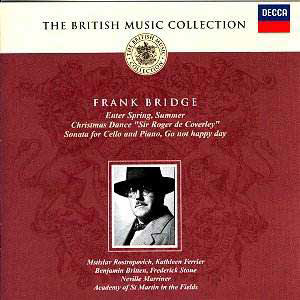Frank Bridge could so easily (and unfairly) be
seen as the follower of various camps. His early British pastoral impressionist
manner hardened in the furnace of the Great War into something far closer
to the Second Viennese School: more Berg than Webern. On one side of
the divide stand works such as the carefree Summer and romantic-impressionist
suite The Sea. On the other side stand works of uncompromising
spareness. The later works include Phantasm (piano and orchestra),
Oration (cello and orchestra) and the String Quartets 3 and 4.
Enter Spring rather confounds the simplistic
idea of a divide. It is a crucible in which the carefree lush pastoralism
of Summer meets impressionism and the Schoenberg of Pelleas
and Melisande. It is a work that sometimes is evocative of the dewy
forests of Bax's Spring-Fire and at others takes on a unique
quality all Bridge's own. The first stirring of the march of Spring
emerges in birdsong and hesitancy but with growing swinging confidence
(9.30). The tolling swaying march bursts with all the confidence and
newness of Nielsen’s life-force. At 11.06 the sub-motif calls out 'blessed
art thou' then the great swinging bell-figure rolls forward with blessed
remorselessness at 11.55. There are even echoes of La Valse at
13.00. The jagged energising hammer-swung power of this music is staggering.
The force which Bridge taps into or expresses is the same force that
blasts forward Nielsen's Fourth, John Foulds' April-England and
even the latter part of Finzi's Hardy song Regret Not Me. This
is the same 'apple-tree shaker' that promises violent rebirth. At one
level the work matches another much later piece - also march-driven
- William Alwyn's Symphony No. 5 Hydriotaphia though the force
of the Alwyn has more to do with tragic mortality than with rebirth.
Marriner makes a very good job of Enter Spring;
better than his Bax November Woods originally issued on the
same CD with Foulds' April-England. Groves in his classic 1974
EMI recording is even better at imparting symphonic weightiness. I always
'feel' Enter Spring as a compact symphony rather like the Alwyn
5, Rubbra 11, Lambert's Music for Orchestra and, further afield,
like Sibelius 7, Pohjola's Daughter and Harris 7.
Summer is done in lush manner. The work is a
gem of almost tactile scene painting. Gentle zephyrs play rather than
rough winds shaking ‘the darling buds of May’. The ASMIF are augmented
to large symphony orchestra proportions and it shows. Marriner gives
Summer its most expansive and confident outing. The work has
links with Butterworth's Shropshire Lad and Two Idylls. Those
summers were soon to be trodden down by muddy boots, field grey, khaki
and tank tracks.
The clever and far from long-winded Roger de Coverley
was also recorded by Bridge pupil, Benjamin Britten. This is played
with elan and explosive pizzicati as well as with a Scottish snap joyously
capped by Auld Lang Syne (a tune on which Joseph Holbrooke in
1917 wrote a set of symphonic variations) kept as a surprise at the
end.
Classic Bridge interpretation for the Bridge Cello
Sonata. What more could you ask? Britten and Rostropovich dig deep into
the continental passion of this compact Sonata. This is the revolutionary
antithesis of the British stiff upper lip caricature. Rostropovich excavates
fathoms of tone and sustains that tone without tremor - rock solid.
This work is from 1917 and if at times it plays as if a Canute-like
spell against the times it is certainly a touching and passionate piece.
In the second movement the confidence has been corroded and the harmony
has soured.
Kathleen Ferrier is as steady of tone as Rostropovich
in Go Not Happy Day though the recording shows its ago in this
fresh company. She does this little song to perfection. I was especially
impressed by her careful attention to dynamics. The song satisfyingly
rounds out this excellent if comparatively short-playing collection.
The brief notes are adequate. No texts for the song,
I am afraid.
Rob Barnett


